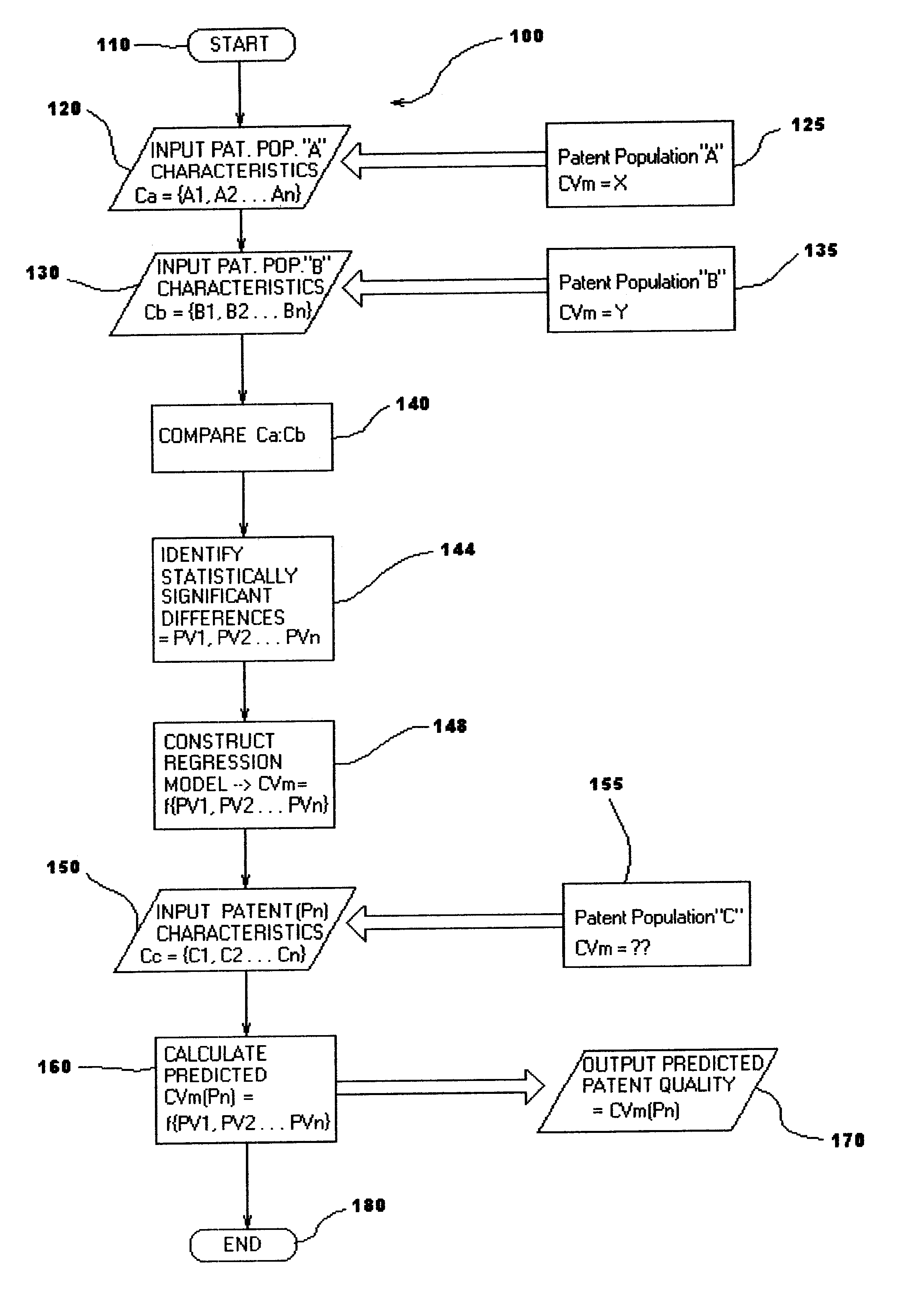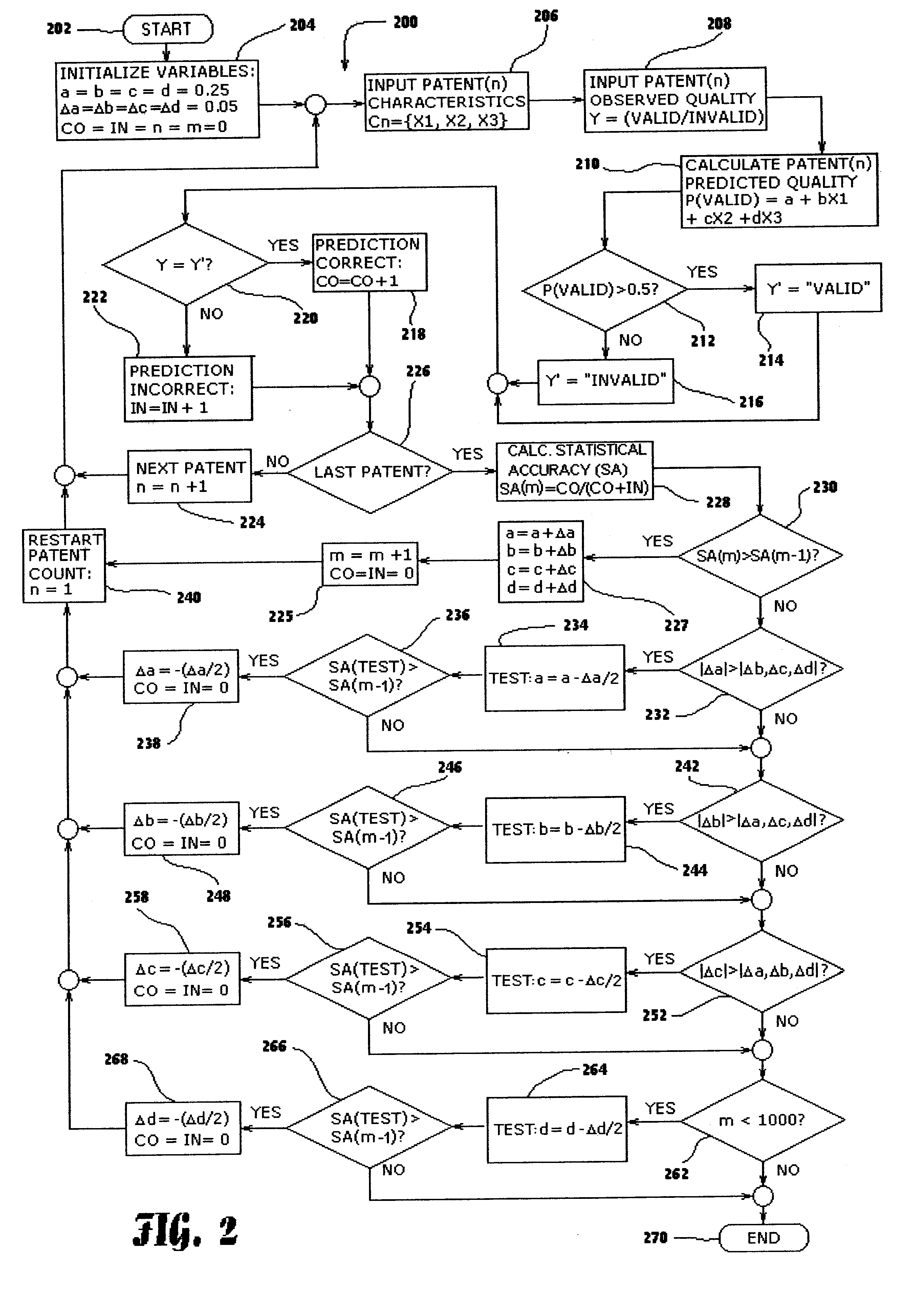Method and system for rating patents and other intangible assets
a technology for intangible assets and valuations, applied in the field of asset valuation, can solve the problems of complex valuation high difficulty in accurate valuing of patents and other intangible intellectual property assets, and high difficulty in valuing assets
- Summary
- Abstract
- Description
- Claims
- Application Information
AI Technical Summary
Problems solved by technology
Method used
Image
Examples
example 1
One possible application of the present invention is to identify and study relevant characteristics from a sample of litigated patents to determine and measure those patent metrics that are predictive of a possible future event, such as a patent being litigated. Patent litigation is the ultimate attestation of patent value. A patent plaintiff is faced with enormous legal costs to bring and prosecute a patent infringement action. Thus, the decision to invest such substantial sums to enforce a patent is potentially (although, not neccessarily) a strong indicator of the strength and value of the underlying patent asset.
A study of statistical data representing about 1200 litigated patents reveals several interesting patterns which can help predict whether a particular patent will be litigated. One pattern that is immediately evident is that patents are typically litigated relatively early in their lives. FIG. 3 is a graph of the average age of a selected sample of litigated patents. Thi...
example 2
Another possible application of the present invention is to identify and study relevant characteristics from a sample of litigated patents to determine and measure those patent metrics that are predictive of a particular desired outcome in litigation (e.g., a finding of infringement and / or invalidity).
For example, it is a commonly-held notion among patent professionals that certain claim language or claim limitations can have narrowing effects on the scope of patent claims. Claims that are very long and recite many detailed limitations or that recite limitations in the form of "means plus function" language and the like can significantly restrict the scope of patent claims. Therefore, it is anticipated that patent metrics reflecting such qualities (e.g., large number of words per claim, or large number of different words per claim, use of "means" language and the like) will have a statistically significant negative correlation with favorable litigation results.
Table 1 below, summari...
example 3
In the United States and most foreign countries, patentees are required to pay periodic maintenance fees during the term of a patent to maintain the patent in force. In most countries, these consist of fixed annual fees of $200-300 per year paid to the government patent office to maintain a patent in force. In the United States, maintenance fees are paid every four years and escalate progressively from $525 / $1,050 to maintain a patent in force beyond the fourth year, to $1,050 / $2,100 to maintain a patent in force beyond the eighth year, to $1,580 / $3,160 to maintain a patent in force beyond the twelfth year. Patentees that qualify as a "small entity" pay the smaller amounts; all others pay the larger amounts.
The relatively substantial and escalating nature of these periodic maintenance fee payments has the effect of discouraging the maintenance for the full-term of all but the most successful or valuable patents. Thus, such patent maintenance fee data provides a unique, introspective...
PUM
 Login to View More
Login to View More Abstract
Description
Claims
Application Information
 Login to View More
Login to View More - R&D
- Intellectual Property
- Life Sciences
- Materials
- Tech Scout
- Unparalleled Data Quality
- Higher Quality Content
- 60% Fewer Hallucinations
Browse by: Latest US Patents, China's latest patents, Technical Efficacy Thesaurus, Application Domain, Technology Topic, Popular Technical Reports.
© 2025 PatSnap. All rights reserved.Legal|Privacy policy|Modern Slavery Act Transparency Statement|Sitemap|About US| Contact US: help@patsnap.com



